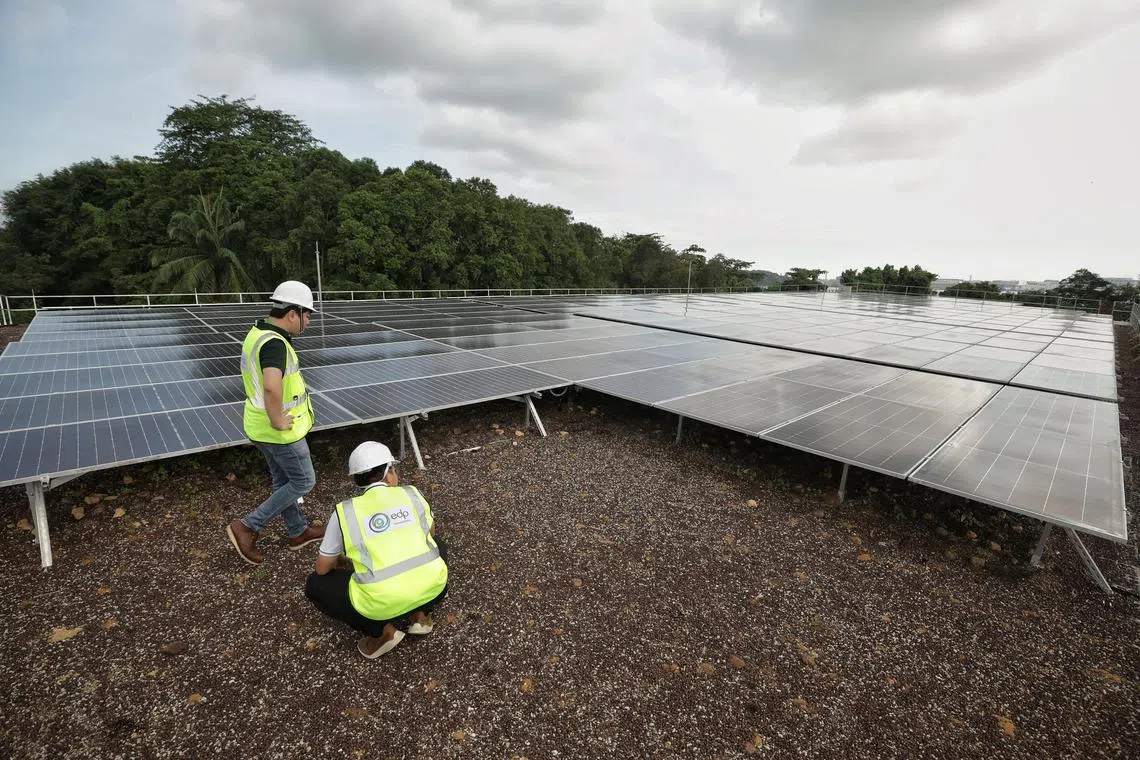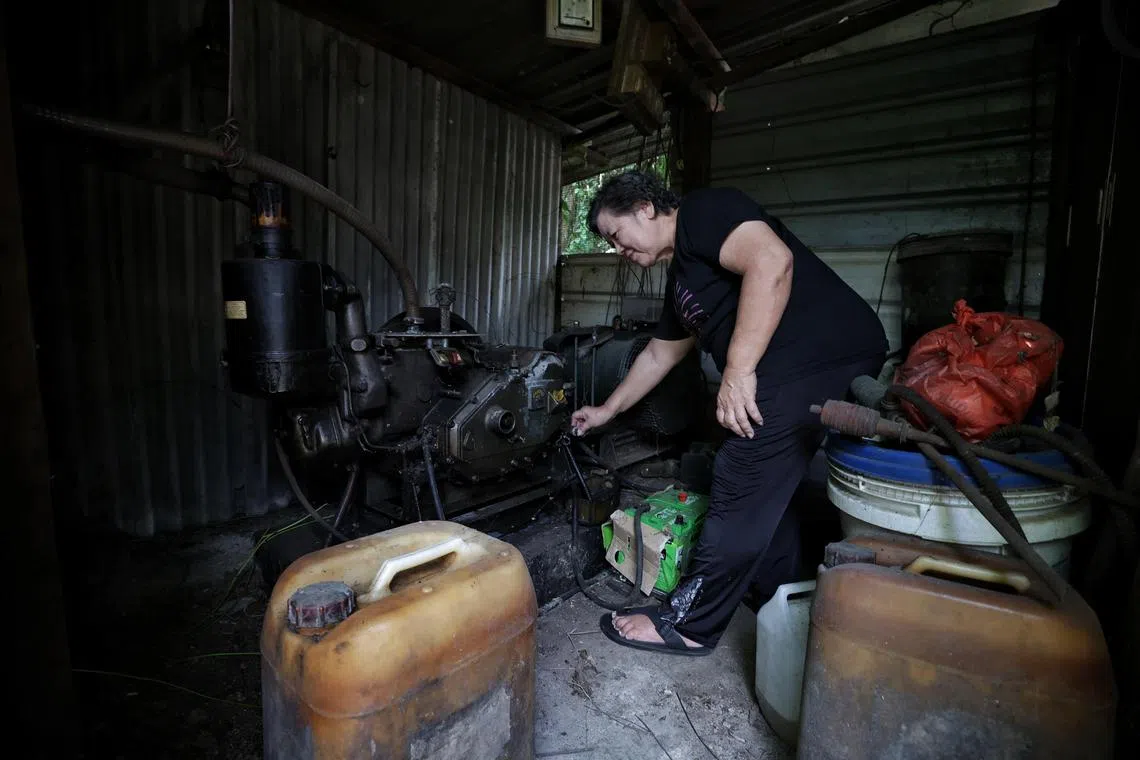Pulau Ubin to derive up to 95 per cent of electricity needs from solar power
Sign up now: Get ST's newsletters delivered to your inbox

Unable to draw electricity from the main electrical grid on mainland Singapore, over 30 households on Ubin now rely on the microgrid.
ST PHOTO: KEVIN LIM
Follow topic:
SINGAPORE - Residents on Pulau Ubin will now use electricity derived mostly from solar power, as the island’s microgrid has been enhanced with more solar panels and batteries, making it more reliable with less of the intermittency that can be a drawback of renewable energy.
Less diesel will now be needed to power the 10-year-old microgrid, which will now draw 95 per cent of its power from the sun,
The microgrid is also a test bed for how clean energy solutions can be incorporated elsewhere, especially on the mainland, said the Energy Market Authority, which established the microgrid in 2013.
Unable to draw electricity from the main electrical grid on mainland Singapore, over 30 households on Ubin now rely on the microgrid while also having their own backup generators.
EDP Renewables spent six months on upgrading works to install 328 kilowatt-peak (kWp) solar panels together with batteries with a capacity to store 1 megawatt-hour of electricity, which is enough to power 83 four-room Housing Board flats.
The energy storage system helps to maintain a consistent supply of energy during periods when solar power generation is low.
Ubin residents welcomed the boost to their grid.

Provision shop owner Madam Ng Ngak Heng has lived on Pulau Ubin for the past 48 years.
ST PHOTO: KEVIN LIM
Especially relieved was shopkeeper Ng Ngak Heng, who said a power outage was out of the question for her business.
The 73-year-old, who took over the running of Yak Hong Provision store from her father-in-law, pays $800 to $1,000 each month for power from the microgrid for her six refrigerators and freezers.
She has spare generators at the back of her store as well, to keep the coolers running for her coconuts, ice creams, drinks and other chilled products. The last power outage was only a few days ago and lasted 30 minutes, she said.

Madam Ng keeps her diesel-powered generator as a contingency in case of power trips.
ST PHOTO: KEVIN LIM
But things are far different from 48 years ago when she moved to Ubin. Recalling how generators were everywhere in the 1970s when every household needed them, she said: “Last time when we had generators, you can hear them all the time, but now with solar, it’s quieter.”
It took getting used to having electricity when they needed it, said temple committee member Doreen Lim, who sleeps at Pulau Ubin Fo Shan Ting Da Bo Gong Temple. She said: “I took a while to get used to the solar power… because we no longer need to use the generators these days, even when the weather has been getting hotter and I’m using more fans than I did a few years back.”

Pulau Ubin Foshan Teng Da Bo Gong Temple committee member Doreen Lim stays on the island most of her time.
ST PHOTO: KEVIN LIM
But a power generator is always on standby during major temple events such as the Hungry Ghost Festival or the 4th lunar month, said the 60-year-old, when more electricity is needed to power spotlights, for instance, during getai.
The temple had experienced five minutes of a blackout in its most recent outage, which is “acceptable”, said Madam Lim. She said the temple usually spends more than $500 a month on electricity.
Residents are now paying 80 cents per kWh – a fixed price till 2034 – with any subsequent price changes requiring approval from EMA. In comparison, electricity tariffs on the mainland will rise from 27.74 cents per kWh in the previous quarter to 28.7 cents per kWh between Oct 1 and Dec 31.
Substituting diesel with solar power can also mitigate volatile fluctuations in energy prices, which have spiked with global inflation in the last couple of years.
Speaking on the sidelines of the launch, Minister in the Prime Minister’s Office Maliki Osman said residents “are actually paying far less than they used to previously (when they had to buy diesel for generators). Now with this, they are likely to pay even less”.
Dr Maliki, who is also a Member of Parliament for East Coast GRC, which Pulau Ubin comes under, added: “I think they (residents) are managing at this point in time, but those who really need help certainly will be provided assistance wherever necessary.”
EDP Renewables Asia-Pacific chief executive Pedro Vasconcelos said: “Microgrids that operate on a standalone basis are fundamental for us to assess their cost competitiveness and... if they can indeed deliver real value to their citizens.”
He added that there are plans to develop another microgrid on another island.

Substituting diesel with solar power can also mitigate volatile fluctuations in energy prices.
ST PHOTO: KEVIN LIM
The Pulau Ubin Micro-Grid test bed helps the authorities understand how innovative clean energy solutions can contribute towards a stable and reliable power grid, said Ms Violet Chen, director of EMA’s Industry Ecosystem and Development Department.
She added: “The test bed augments EMA’s efforts to integrate more clean energy solutions into the grid while scaling up Singapore’s solar deployment to achieve at least 2 gigawatt-peak by 2030.”

